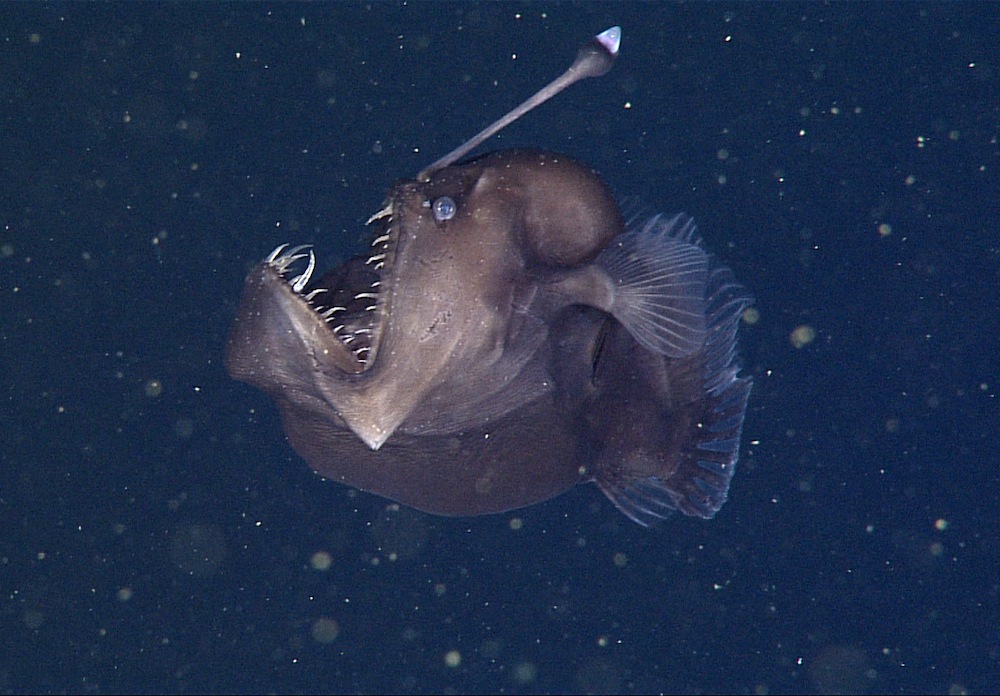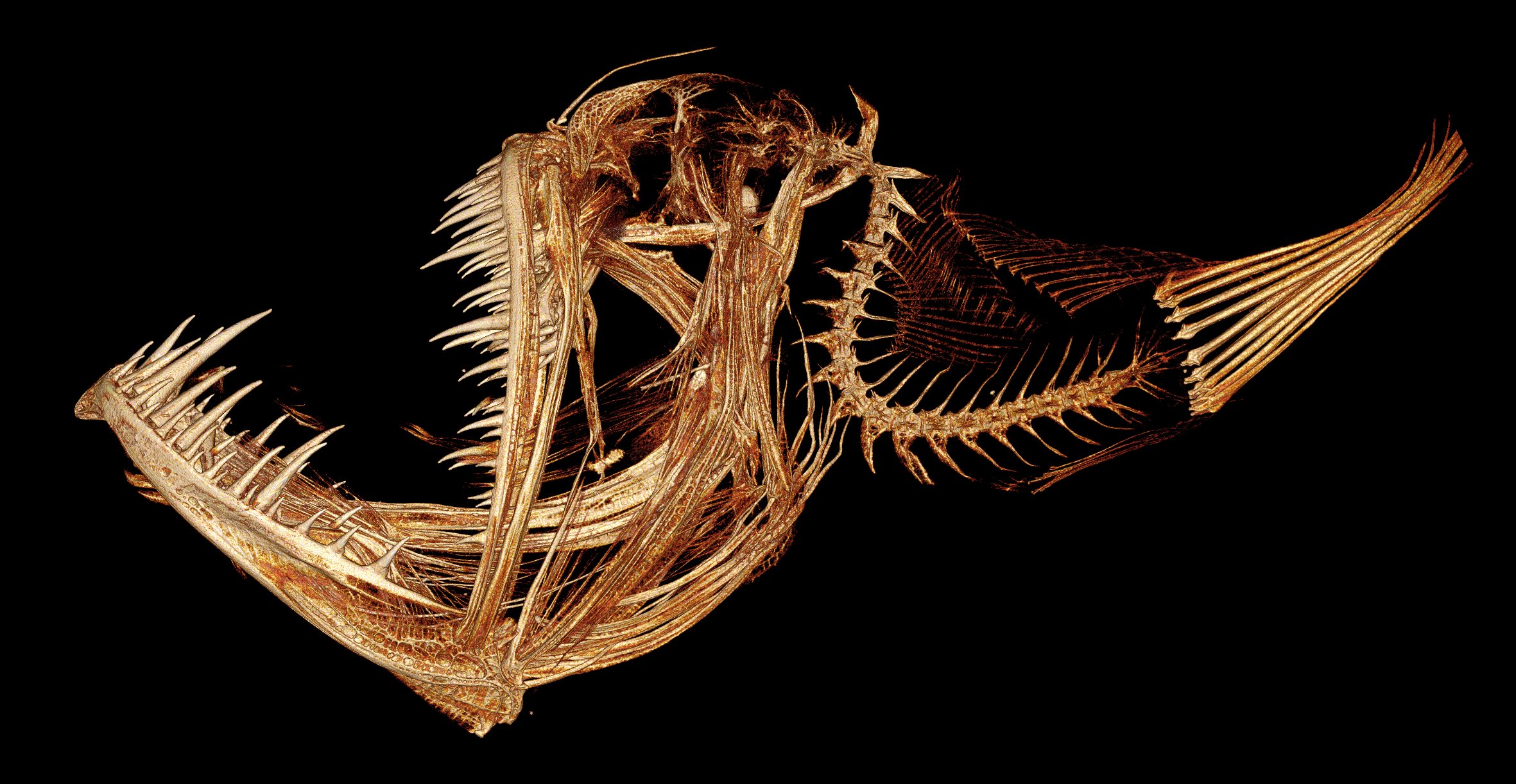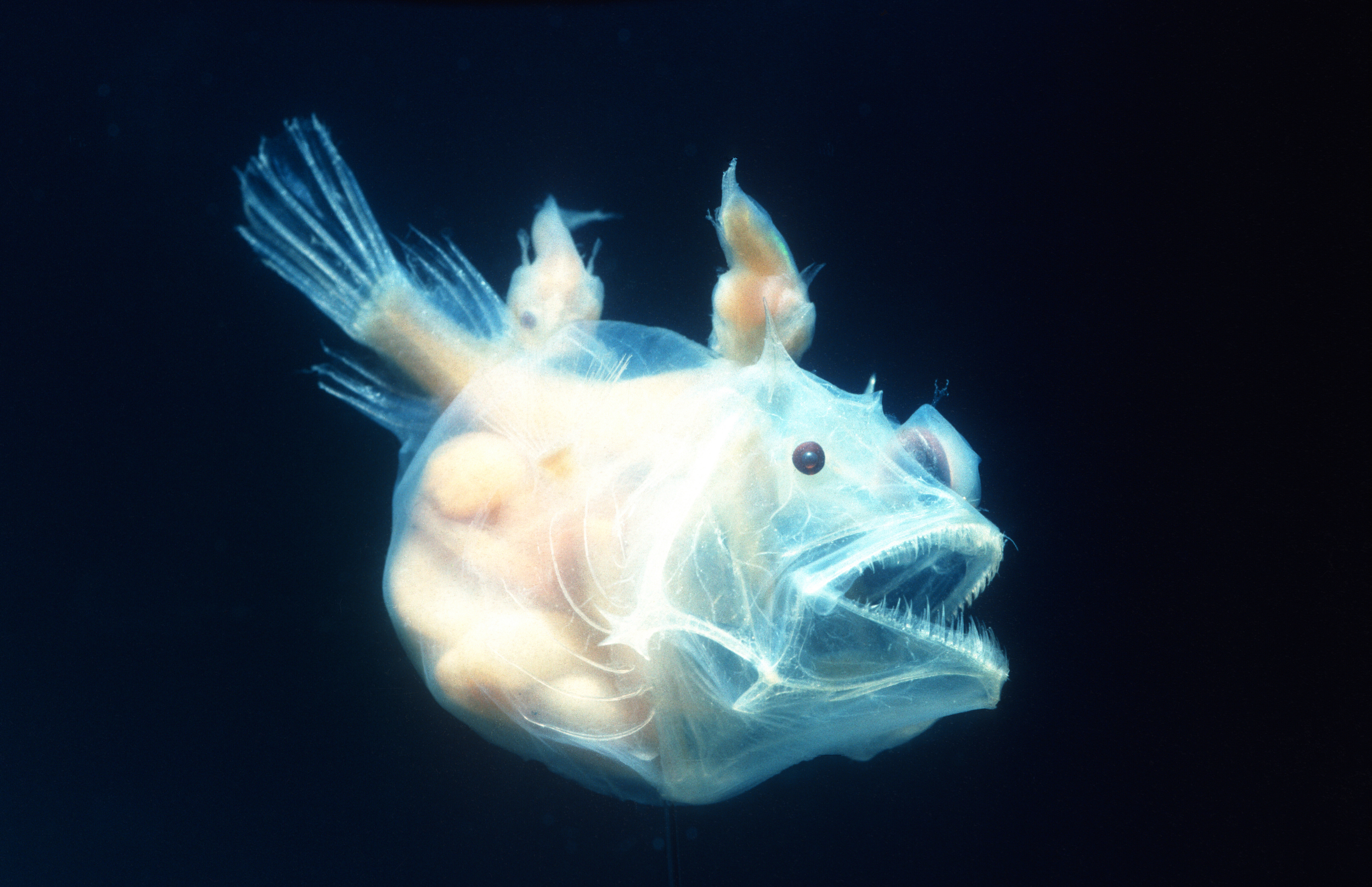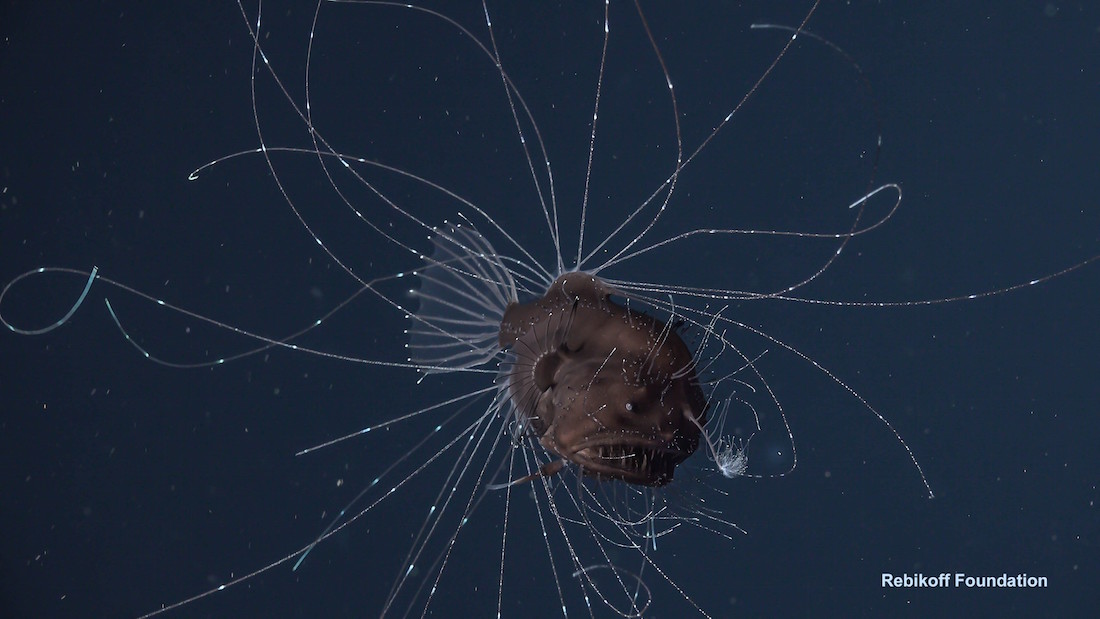More Than You Need to Know About Fishes
Anglerfish are stranger than scientific discipline fiction
In 1833, an almost perfectly spherical fish washed ashore in Greenland and was taken to zoologist Johannes Christopher Hagemann Reinhardt in Copenhagen, Denmark. This fish — later known as the footballfish, Himantolophus groenlandicus, or the homo-gobbler — was the first anglerfish known to science, wrote Ted Pietsch, a systematist and evolutionary biologist, in his book "Oceanic Anglerfishes" (Academy of California Printing, 2009).
Today, there are about 170 known species in 12 families of deep-sea anglerfish, and a "huge diverseness" within those families, Mackenzie Gerringer, a professor of biological science at SUNY Geneseo in New York who specializes in deep-sea fish told Alive Science. Mutual names for anglerfish hint at some of the wild forms they can have — snaggletooth sea devil, wolf trap and pugnacious dreamer (also known equally the tyrannical toad), to name just a few. They sport a fantastic range of shapes and textures; some are squat and round (Melanocetus johnsonii), while others are flat and huge-snouted (Thaumatichthys binghami) or covered in whiskery filaments (Caulophryne jordani). But while these fish are found all over the world, they are adequately elusive, solitary creatures — par for the class for a fish that lives 1,000 to 16,400 feet (300 to 5,000 meters) below the surface. Every bit a effect, new species are nevertheless beingness discovered, each more foreign than the last.
But no matter what it looks similar, any deep-sea anglerfish is a minor body of water-dwelling creature'southward worst nightmare.
Related: Bizarre fish are deadly abyssal predators (and Twitter stars)
Luring in the unlucky

Anglerfish are named for the glowing lure they utilize to attract the fish and crustaceans they eat. These fearsome hunters lurk quietly in the depths of the ocean. They're ambush predators, Gerringer said, floating and waiting in the night until casualty comes well-nigh. Then, they use their congenital-in angling rod to lure in the unlucky animal, wiggling, hiding and revealing their lure to tempt potential prey until they are close plenty to be sucked upwardly.
This feeding strategy explains anglerfish's bodies: Because they don't actively chase, they haven't evolved to exist fast swimmers, which is why many are blobby, not-hydrodynamic shapes. National Geographic even called anglerfish "quite perchance the ugliest animal on the planet" (though the blobfish would like a word).
Related: This terrifying, toothy 'monster' is the world's deepest-living predator.
In the deep ocean, meals are few and far between. Pietsch wrote in Oceanic Anglerfishes that most anglerfish stomachs that have been examined are empty. Then when an anglerfish does come across a meal, they make it terminal. Anglerfish mouths are often the biggest part of their bodies, and if a meal "can fit in the oral fissure, it can fit in the trunk," Gerringer said. Many anglerfish tin can stretch their stomachs to double their original size.
"They'll end up with a chimera belly," she told Live Science. "Sometimes they're defenseless and they have whole fish in their stomachs. If you bear on the stomachs, it's quite squishy, for lack of a amend term."
Just don't worry likewise much well-nigh these abyssal horrors: They're far also pocket-sized to hurt a human, making their oversized teeth and misshapen bodies… kinda beautiful? While some anglerfish tin can grow up to three or four feet (0.9 to 1.ii yard) long (like Ceratias holboelli), the average size of an adult is 6 inches (xvi centimeters) long — a little smaller than a volleyball.
Glow up
Anglerfish lures glow in the deep body of water, at to the lowest degree half a mile (0.8 kilometers) beneath the sunlit surface, thanks to luminescent bacteria that accept root in the fish'south lure. The lure, as well called an "esca," has a pore on the end that is designed to host these bacteria, many of which can't live anywhere else, and many of which are unique to that species of anglerfish.
Related: Check out an image gallery of glowing fishes.
Simply where do the glowing bacteria come from? Anglerfish are built-in deep in the body of water as tiny, transparent larvae and bladder lone to the surface to feed and develop into their adult forms. They don't grow an esca until afterward in life, so they accept nowhere to nurture their bacterial colonies from birth, Gerringer said. "Information technology's a big research question correct at present," she added. Of the anglerfish esca bacteria that have been studied, none take been establish living freely in seawater, Pietsch wrote in his volume, significant that information technology's unlikely the fish pick their glowing buddies up from their environment. Do they live on an anglerfish's skin until the esca develops? Do they, every bit one study in the journal eLife suggested in 2019, come up from developed anglerfish spewing bacteria into the water, to be immediately picked up past younger fish? "There's a lot of open questions," Gerringer said.
Related: More fish glow than researchers previously expected.
The diverse anglerfish don't cease at a simple glowing lure, though. Some species, such every bit Phyllorhinichthys balushkini, have elaborate light guides protruding from their bodies, similar biological fiber optic cables. Others, like Cryptopsaras couesii, have glowing spots on their backs called caruncles. Some, like members of the Thaumatichthys genus, have lures on the roofs of their mouths.
Snapping the trap with anglerfish teeth

Once an anglerfish has lured in its prey, the fish has every incentive to go on information technology. According to Karly Cohen, a PhD candidate studying the biomechanics of fish teeth at the University of Washington, nigh animals sport teeth that are firmly attached to their jaws — with anglerfish equally a notable exception. Some of their fang-like teeth are "depressable," or able to fold in under pressure. "It could exist that the teeth are working similar to a spike guard in a parking garage," Cohen told Live Science. "Information technology's like shooting fish in a barrel for prey to go in the oral fissure, but hard for them to get out."
To sympathise anglerfish teeth, Cohen uses a technique called histology. She embeds teeth into resin blocks, and and then slices that block microscopically thin. That way, she and her colleagues can stain and place specific tissues (enamel, pulp and ligaments, for example) to determine how those teeth developed.
But a newer technique allows Cohen to get an even meliorate look at i anglerfish'due south jawful of fangs. Using a CT scan, Cohen about sliced the entire fish into sections that could so exist reassembled digitally and viewed from any bending.
Unlike us, Cohen said, "fish put teeth everywhere," and often in places that are hard to spot while merely looking at a specimen. With a 3D rendering of a tiny (merely ferocious) fish similar Melanocetus johnsonii, just 2 inches (5 cm) in length, Cohen and her colleagues can brand meliorate models of these elusive animals' bite.
The worst sexual practice on Earth

Many species of abyssal anglerfish have one of the weirdest reproduction strategies on the planet. Males are parasites — and we don't hateful that metaphorically.
In many abyssal anglerfish species, the males are often ten times smaller than females, said Gerringer, and they have no function other than to reproduce. They use highly developed aroma organs to track down females. When they notice one, they bite into her: According to Cohen, some male person anglerfish develop specialized hooked teeth in front of their mouth specifically for getting a grip. (Cohen is researching whether these teeth are true teeth or a kind of proto-tooth chosen odontodes.) Then, they release an enzyme that dissolves the skin of their oral cavity, fusing with the female's torso. The males become completely dependent on the female person for sustenance; their circulatory systems merge and so that they're sharing the aforementioned blood, and substantially the males become a living pair of testicles.
"Since there'southward a low probability to run into each other in the ocean, you desire to be able to stick together when you discover a mate. And they take this to the farthermost," Gerringer said.
Read more: Anglerfish sex is even weirder than we thought
Females don't end collecting partners when they accept one male fused to them: The record, Gerringer said, is 12 males to one female person.
The fusing that takes place is similar to an organ transplantation, since the males essentially become a office of the female's body. Enquiry published in the journal Science in 2020 found out how anglerfish manage this feat: They lack genes to produce almost of the molecules that would attack foreign tissue — plus they take few or no T-cells and antibodies. This lack of an allowed system would probable kill a homo, study co-author Dr. Thomas Boehm said in a press release describing the report, but information technology's exactly what anglerfish need to conduct out their weird sexual parasitism-based reproduction.
Changes in the deep sea

Not many creatures in the ocean eat anglerfish (although some take been found in the stomachs of other deep-body of water predators, such as the Antarctic toothfish, Dissostichus mawsoni), and since anglerfish make their dwelling house in deep water, they are not actually targeted or accidentally caught by humans. Then yous might think that the anglerfish population is perfectly safe.
Yet, that'south not the case. "We call up of deep ocean communities every bit being out of sight, out of mind, but they're closely connected to the rest of the ocean ecosystem," Gerringer said. A recent opinion article published in the periodical Proceedings of the National Academy of Sciences argued that deep-sea mining in search of increasingly deficient rare earth minerals could become a threat to the body of water. The emerging technology, as reported by Nature, could shoot sediments and mining waste from the seafloor up into the h2o cavalcade where information technology could remain in the mid-body of water. That habitat is home not just to anglerfish but tens of thousands of other species, according to a report in Science Daily. That muck could clog upwardly gills, starve filter-feeders and change the way light — and the attraction of an anglerfish's esca — travels in the ocean.
Related: RIP, polish handfish. You we re weird, and now you're extinct.
Climate change is a threat as well, Gerringer said, past increasing ocean stratification. This means that water isn't mixing from the surface down into the deep ocean equally much as it used to, so less oxygen is making its way down to the depths. Ultimately, though, anglerfish are nevertheless then mysterious that for many, "we just don't know" how humans might affect them, Gerringer said — or even what their baselines are.
But technology is improving all the time. In 2014, the Monterey Bay Aquarium Inquiry Institute captured the first ever video of a "black seadevil" anglerfish and and so brought it to the surface for a closer look, expecting that the fish wouldn't live long at sea level. But in 2018, National Geographic reported how scientists' ability to safely bring live deepwater fish to the surface is evolving. Someday soon, thanks to developments like these and the continued exploration of the deep ocean, we may know more than about these bizarre, mysterious creatures.
Additional resources
- Explore the deep-sea anglerfish family on the Tree of Life.
- Run across more than facts about the body of water's "twilight zone" from the Wood Pigsty Oceanographic Institute.
- Check out this stunning first video footage of a mated pair of anglerfish.
garciadeprectuod41.blogspot.com
Source: https://www.livescience.com/deep-sea-anglerfish.html

Post a Comment for "More Than You Need to Know About Fishes"